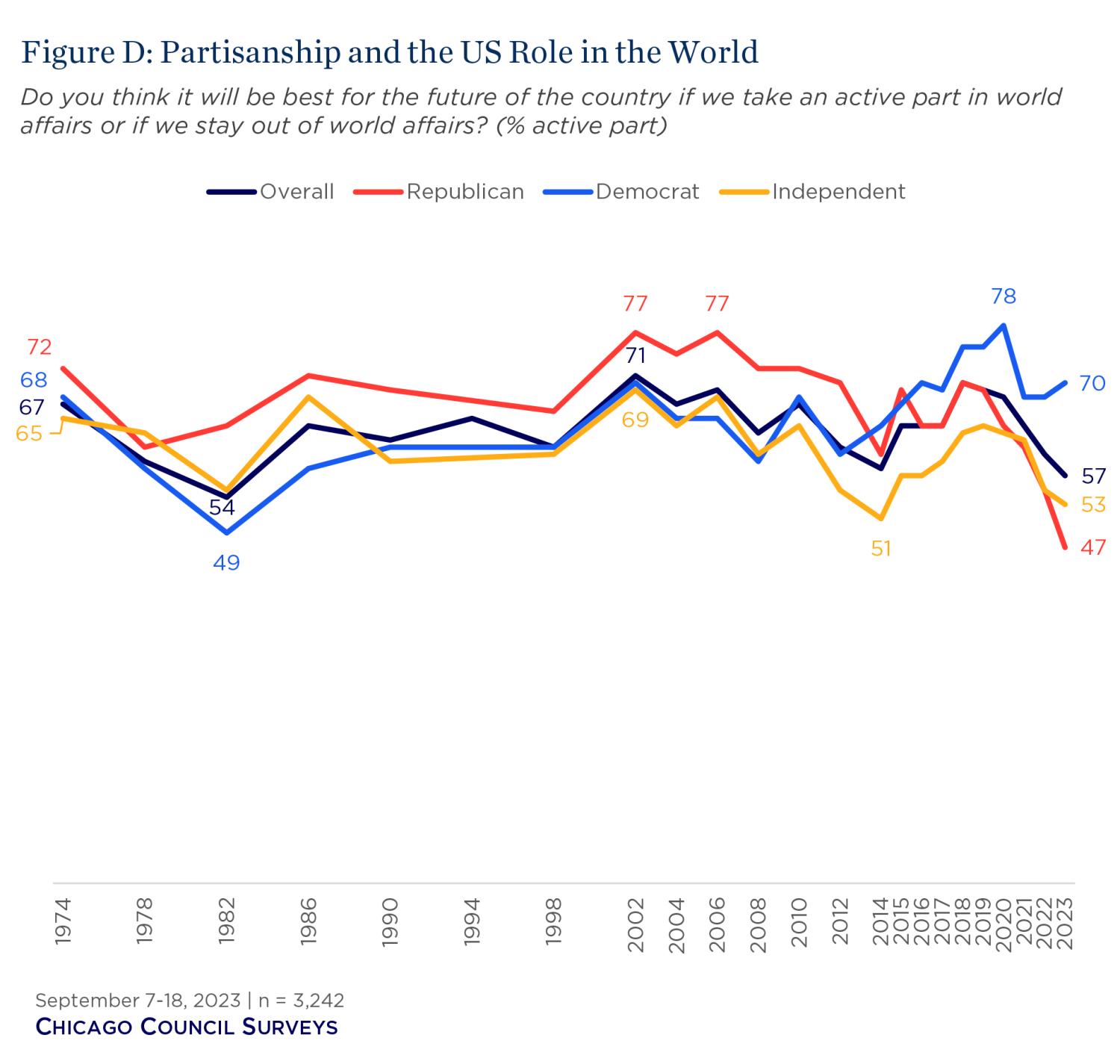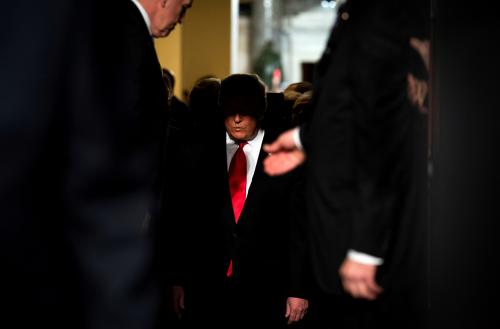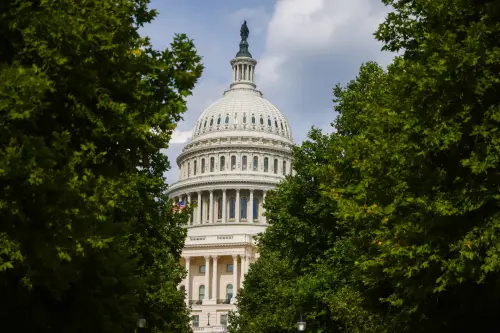This piece updates a 2019 article originally published by The Ripon Forum.
Eight decades of American foreign aid has generated confusion among U.S. taxpayers on how and how many tax dollars are spent on foreign assistance.
As we are in the midst of an election cycle, it is important that candidates, voters, and media have a better understanding of how taxpayer dollars are currently used to advance our national interest.
What is foreign aid?
Foreign assistance falls into one of three basic categories:
- Humanitarian assistance (food, medical care, shelter, security) for life-saving relief from natural and manmade disasters.
- Development assistance that promotes the economic, social, and political development of countries and communities.
- Security funding that helps strengthen the military, police, and other security forces of a country.
The relative proportions vary each year. The 2022 budget of $70 billion was representative of the split, with humanitarian assistance accounting for approximately one-quarter, development assistance for almost two-thirds, and security assistance less than one-fifth.
Very little assistance is delivered as cash to governments, a recent exception being support for the government of Ukraine (the use of which is checked and rechecked) in response to the Russian invasion. Most funds for humanitarian and development assistance are provided through U.S., global, and local organizations and businesses.
How much of US gross domestic product (GDP) is devoted to foreign aid?
Historically, as demonstrated by the chart below, foreign aid peaked at 3% of U.S. GDP during the Marshall Plan program to resuscitate Europe following the end of World War II. Subsequently, it ranged from 1% to just less than 0.5% during much of the Cold War. In recent decades, it has hovered in the range of less than 0.33% of U.S. GDP.
In terms of the federal budget obligations, foreign assistance accounts for about 1%. In fiscal year 2022, foreign assistance totaled $58 billion and in fiscal year 2023 about $63 billion (final figure not available).
YES & NO. The U.S. is both generous and penurious—it provides more official government assistance than any other country, but considerably less as a portion of our national income. There is a broad international commitment (to which the U.S. has never pledged) that wealthy countries should annually provide 0.7% of GDP to assist developing countries. For 2023, five countries—Norway, Luxembourg, Sweden, Germany, and Denmark—met or exceeded that benchmark. The average for all wealthy nations is around 0.3%, with the U.S. ranking at the bottom.
As to giving by the American people, the most recent (2020) compilation of all U.S. private (individuals and institutions) contributions to overseas causes totaled $49.3 billion; the level of official U.S. foreign assistance expenditures for that year was $47 billion.
Which US government agencies are responsible for foreign assistance?
The U.S. foreign assistance structure is complex with more than 20 U.S. government agencies have a role in providing foreign assistance. The most recent data (2022) shows the principal agency for foreign assistance, the U.S. Agency for International Development (USAID), responsible for some 60% of foreign assistance, followed by the Department of State at nearly 30%, the Department of the Treasury at 5%, the Department of Health and Human Services at 3%, and the Departments of Defense and Agriculture and the Millennium Challenge Corporation each under 1%.
Does foreign aid go to corrupt, wasteful governments?
NO. It can be difficult to identify with precision who implements all of assistance. A sizeable portion of U.S. assistance is passed from one U.S. government agency to another for further subsequent allocation to other implementing entities. When the money does eventually leave the U.S. government, the graph below shows that only a small fraction goes directly to other governments. In the period 2015-2022, just less than 20% went to nonprofit organizations, a little over 10% to the private sector, and less than 20% to multilateral organizations. While the U.S. provides assistance directly to only a few governments, recipient countries—and therefore government—indirectly benefit from the services and support provided to local communities and organizations.
Typically, when the U.S. wants to support communities and people and bolster reform in a country that is ruled by a corrupt, uncooperative government, U.S. assistance goes through private channels—NGOs, community groups, businesses, universities, other private entities—or international and multilateral organizations. Accountability of U.S. economic assistance is high—the U.S. imposes stringent, some would say onerous, reporting and accounting requirements on recipients of U.S. assistance, and the General Accounting Office and agency inspector generals investigate possible misuse.
Does foreign aid go to autocratic governments?
LESS SO TODAY. During the Cold War struggle to stem the spread of communism, when foreign aid was often based on the premise that “the enemy of my enemy is my friend” no matter what the nature of the government, aid did find its way to autocratic governments. That substantially changed in the 1990s following the demise of the Soviet Union. However, there are countries that are at best “semi-democratic” and with autocratic elements but where U.S. assistance ends up. This assistance goes mostly through civil society organizations for humanitarian reasons or because of strong U.S. security interests in their stability and that of neighboring countries. However, there is reason to worry that less concern with autocracy may reappear with the abiding anxiety over terrorism and conflict in our post-9/11 era and in a world increasingly dominated by geopolitical considerations, highlighted by concerns over anti-Western and anti-rule-of-law attitudes and actions by countries such as Russia, China, Iran, and North Korea.
Does foreign aid produce concrete results?
YES. The U.S. government requires regular monitoring and reporting on how and whether assistance programs are working, and periodic evaluations of results. There is evidence that development and humanitarian programs produce considerable results, but less so for programs driven by foreign policy and security purposes. While foreign assistance is by no means the only driver of human progress, which rests primarily in the hands of the government and people of each country, it does contribute in specific areas and to the overall environment supporting human advancement and has chalked up notable successes.
Of particular note:
- The Marshall Plan in the early 1950s played a critical role in reviving the economies of Europe following World War II and is credited with helping to fend off communism in Western Europe.
- The Green Revolution for which foreign aid in the 1960s financed agricultural research that produced new varieties of seeds, increased use of fertilizers, and improved farming practices that expanded agricultural output in developing countries, including moving countries in Asia from periodic bouts of hunger and famine to being agriculture exporters.
- The U.S. PEPFAR program in a period of 20 years (2003-2023) has saved 25 million lives from HIV/AIDS and enabled 5.5 million babies to be born HIV-free.
Further, the record of the advancement of human welfare to which foreign assistance has and is making a contribution—but by no means has played the primary role—is impressive, including:
- People are being lifted from poverty: “The number of people living in prosperity is growing by about 85 million every year. If current trends continue, the world will experience a tipping point in 2049 when the prosperous will outnumber the non-prosperous for the first time.”
- Extreme poverty has fallen dramatically over the past 32 years—from 2 billion people (36%of the world’s population) in 1990 to 712 million (9%) in 2022.
- The global maternal mortality ratio declined by 34% from 2000 to 2020.
- Life expectancy globally has more than doubled from 32 years in 1900 to 71 years in 2021.
- Smallpox has been defeated; polio has decreased 99% and is declining in the two countries (Afghanistan and Pakistan) in which it has been endemic; deaths from malaria in Africa were cut in half from 2000 to 2015.
- Assistance programs can help promote national economic progress and stability, making it more viable for citizens to remain at home rather than migrate to other countries.
Does foreign aid benefit the US or countries we support?
BOTH. Foreign aid typically aims to support economic, social, and political development and security of recipient countries and their people. At the same time, such assistance also advances one or all of the following overriding U.S. interests:
- Contributing to U.S. national security by supporting allies in promoting regional and global stability and peace and addressing transnational threats such as pandemics, trade in narcotics, and non-state malign actors.
- Reflecting the core U.S. value of caring for others in need—providing humanitarian assistance to victims of war, violence, famine, and natural disasters.
- Advancing U.S. and recipient economic interests by building economies and markets. For example, U.S. goods and services exports to the 11 European and Eurasian countries that have graduated from assistance have increased from more than $2 billion in 1995 to over $10 billion in 2015.
In addition, a sizeable portion of U.S. assistance is spent in the United States on the purchase of food aid, medicines, equipment, and salaries of Americans who manage projects and provide technical advice.
Do the American people support foreign aid and active engagement in world affairs?
YES. While the term “foreign aid” is not universally popular and polling reveals that some feel our foreign policy is overextended and would prefer the money be spent to fix our own problems, Americans support U.S. active engagement in the world. Polling over several decades shows consistent approval of U.S. assistance efforts, with support particularly strong for purposes such as humanitarian assistance, improving people’s health, advancing rights and opportunities for women and girls, educating children, and helping poor countries develop their economies.
A June 2024 poll by the Reagan Institute found that 54% of Americans believe the U.S. should be more involved and lead in international affairs versus 33% who want less U.S. engagement.
The poll further reveals that 57% think U.S. involvement is beneficial for our country; 78% believe leadership is essential for promoting trade and boosting our economy; 77% that the U.S. has a moral obligation to stand up for human rights and democracy; and 86% that a strong military is essential to maintaining peace and prosperity.
Is support for international engagement and foreign aid partisan or bipartisan?
BIPARTISAN. This may seem surprising given recent political divisiveness.
Over the past 50 years a majority of Americans—Democrats, Republicans, and Independents—have supported U.S. active engagement in world affairs. Up until the past decade, Republicans were somewhat more supportive than Democrats and Independents. But, as shown in the chart below, since 2016 the positions of those who identify as Democrats and Republicans have flipped, with Democratic support increasing and Republican support declining (see chart below from the Chicago Council on Global Affairs).
Source: The Chicago Council on Global Affairs. “A Cost of Conflict: Americans Turn Inward. Results of the 2023 Chicago Council Survey of American Public Opinion and US Foreign Policy.”
But looking at foreign assistance, historically, Democratic policymakers (administrations and Congress) have been more supportive than Republicans policymakers. Take the Truman administration, which initiated the Marshall Plan. Or, in the 1990s, when votes in Congress on foreign aid spending were close, appropriations bills garnered more Democratic than Republican votes. Yet every president, Democratic and Republican, apart from Donald Trump, has been a strong proponent of foreign aid.
In fact, some of the most rapid increases in foreign aid have come during Republican presidencies. For instance, despite George W. Bush being a skeptic of foreign aid before entering the White House, the budget for foreign assistance double from $16 billion in 2001 to $33 billion in 2004. Since the creation in the early 2000s of President Bush’s well-regarded signature programs—the Millennium Challenge Corporation, the President’s Emergency Plan for AIDS Relief (PEPFAR), and the President’s Malaria Initiative—foreign aid carries a Republican as well as a Democratic brand and has received congressional support from both parties.
There was bipartisan rejection of proposals by the Trump administration to cut the U.S. international affairs budget by one-third, and, although in 2024 a small number of congressional opponents succeeded in delaying congressional consideration of supplemental foreign aid legislation, the bill passed the Congress with bipartisan support. On June 28, 2024, 80% of the members of the U.S. House of Representatives on a bipartisan vote rejected an amendment to eliminate foreign assistance from the Fiscal Year 2025 federal budget.
In sum
A majority of the American people appear to understand that providing assistance to countries and people in need—whether for reasons of humanitarian relief, economic advancement, or security—advances the best interests of both the recipient country and America. We often disagree over the amount of support and to whom and how it should be provided, but collectively we understand that foreign assistance is an extension of American values and self-interest—our national interest in terms of our own and other countries’ security, economy, and humanitarian values.
Cover photo source: Melinda Donnelly for USAID/Oceans via USAID Digital Development on Flickr, CC BY
Note: A previous version misstated the figures for extreme poverty (incorrectly citing 9 billion instead of 2 billion) and the year from which life expectancy doubled (from 1900, not 1990). The text has been corrected.
-
Acknowledgements and disclosures
Charlotte Rivard provided graphic and research support for this piece.
The Brookings Institution is committed to quality, independence, and impact.
We are supported by a diverse array of funders. In line with our values and policies, each Brookings publication represents the sole views of its author(s).





Commentary
What is US foreign assistance?
September 12, 2024